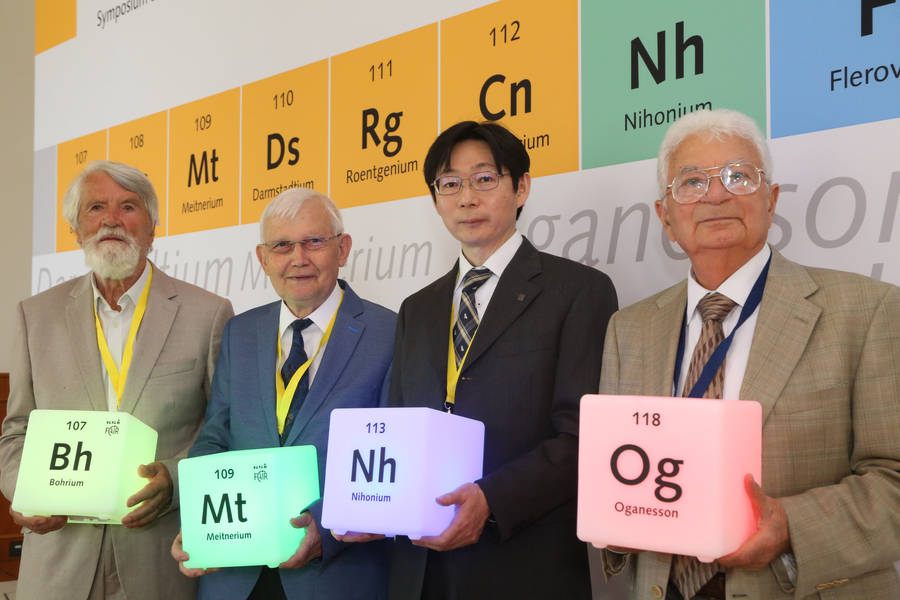Historic meeting of the discoverers of chemical elements
News, 27 August 2019
As part of the International Year of the Periodic Table of Chemical Elements 2019, the Conference on the Chemistry and Physics of Heavy Elements (TAN) taking place in Wilhelmshaven, Germany from the 25th to the 30th of August, brought together the discoverers of new chemical elements in a unique historic gathering. Researchers from Germany, Russia and Japan, who have added new elements to the periodic table in recent years, met at the international congress.
 The four element discoverers — from left: Professor Peter Armbruster and Professor Gottfried Münzenberg, Helmholtz Centre for Heavy Ion Research (GSI), Darmstadt; Dr. Kouji Morimoto, RIKEN Nishina Center for Accelerator-Based Science, Wako, Japan; Professor Yuri Oganessian, Flerov Laboratory for Nuclear Reactions, Dubna, Russland / Photo: Björn Lübbe, Wilhelmshavener Zeitung
The four element discoverers — from left: Professor Peter Armbruster and Professor Gottfried Münzenberg, Helmholtz Centre for Heavy Ion Research (GSI), Darmstadt; Dr. Kouji Morimoto, RIKEN Nishina Center for Accelerator-Based Science, Wako, Japan; Professor Yuri Oganessian, Flerov Laboratory for Nuclear Reactions, Dubna, Russland / Photo: Björn Lübbe, Wilhelmshavener Zeitung
Professors Peter Armbruster and Gottfried Münzenberg, who held leading positions in the production of elements 107 to 112 (bohrium, hassium, meitnerium, darmstadtium, roentgenium and copernicium) in the Helmholtz Centre for Heavy Ion Research (GSI) during their active research careers, are present at the conference. Dr. Kouji Morimoto from Japan of the RIKEN Nishina Center for Accelerator-Based Science, who was a member of the element 113 discovery team, attends as well. Professor Yuri Oganessian (JINR, Dubna) is also on site. He was head of the discovery team of Elements 114 to 118 (flerovium, moscovium, livermorium, tennessine and oganesson) at the Flerov Laboratory of the Joint Institute for Nuclear Research, JINR in Dubna, Russia. He is currently the only living person an element is named after: element 118, oganesson. The current heads of GSI, the Flerov Laboratory and the RIKEN Nishina Center, where the respective elements were discovered, also participate in the conference.
Professor Sergey Dmitriev, Director of the Flerov Laboratory of Nuclear Reactions (FLNR) said at the congress: “Priority experiments on the synthesis of new superheavy elements — flerovium (114), moscovium (115), livermorium (116), tennessine (117), oganesson (118) — were carried out at the FLNR using the U-400 accelerator. Further progress required the construction of a Superheavy Element Factory at FLNR whose key facility is the DC-280 cyclotron with the ion beam intensity an order of magnitude higher than that achieved to date. The commissioning of the Factory will allow experiments on the synthesis of the elements 119 and 120 and will significantly expand the work on the study of nuclear and chemical properties of superheavy elements.”
A total of 120 researchers from 19 countries and 4 continents take part in the TAN conference. During the conference week, they discussed the current results and perspectives of research on the so-called transactinides, the namesakes of the TAN conference series. This refers to the elements starting with the atomic number 104 which follow the subgroup of actinides.
The Helmholtz Centre for Heavy Ion Research in Darmstadt (GSI), the Johannes Gutenberg University and the Helmholtz Institute Mainz are the organizers of this year’s TAN conference.
Following the article on eps.org